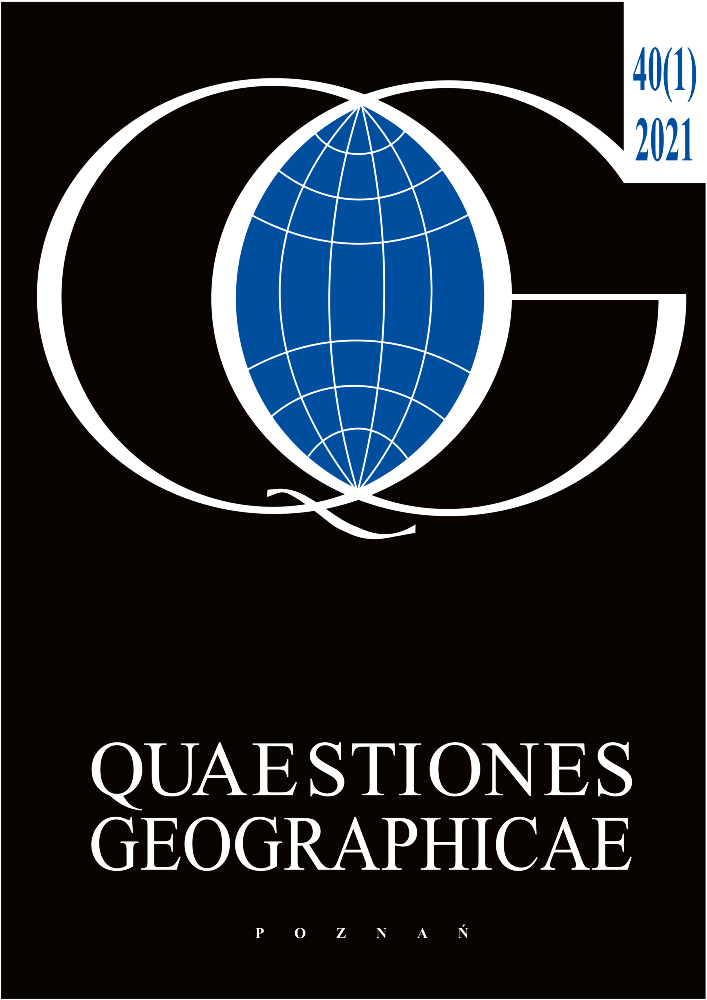Abstract
A change in livelihood and folk architecture is an indicator of cultural landscape transformation, which is often the result of changes occurring in the natural and socio-political realms. The diversity of architectural types of buildings as an element of landscape diversity distinguishes our research region. The presented study deals with a long-term change of housing and architectural types of settlements. Our goal was to identify, geolocalise, and classify the vernacular architecture of Samtskhe-Javakheti within the different types of natural landscapes. For this purpose, we used the HGIS (Historical Geoinformation System) approach, which comprises the application of both historic sources and GIS technologies. We identified seven types of buildings in the study area, the characteristics of which depended on the natural landscape features. The following factors had been determining the geography of the construction: geology, seismicity, terrain, climate, access to building materials and defence. Dominant architectural types of buildings in the study region were as follows: fortress Rabat with stone houses, stone houses, semi-underground houses mixed with stone houses, semi-underground houses, terraced semi-underground houses, cave dwellings and wooden log houses. In modern times, it is quite rare to come across these kinds of architectural buildings, and there is a tendency of their disappearance.
Funding
This research was supported by the Shota Rustaveli National Science Foundation of Georgia (SRNSFG) [grant number YS-2016-44].
References
Adamia I., 1967. Qartuli satskhovrebeli sakhlebis udzvelesi tipebi acharashi (The oldest types of Georgian houses in Adjara). Monument’s Friend 12: 3–12.
Aslanikashvili A., 1953. Gurjistanis vilaietis ruka (Map of the Gurjistan Vilayet). Georgian SSR Academy of Sciences, Institute of Linguistics, Tbilisi.
Battaini-Dragoni G., 2008. The rural vernacular habitat, a heritage in our landscape. Futuropa, for a new vision of landscape and territory 1: 3.
Berdzenishvili D., 1988. Vardzia da tmogviscixe-qveyana (Vardzian and Tmogviland). Monument’s Friend 2: 46–54.
Beruchashvili N., 1995. Kavkaz: landshafti, modeli, eksperimenti (The Caucasus: Landscapes, Models, Experiments). Tbilisi State University Press, Tbilisi.
Black F.A., MacDonald B.H., 2005. HGIS of print culture in Canada. Historical Geography 33: 154–156.
Braudel F., Wallerstein I., 2009. History and the social sciences: The Longue Durée. Review (Fernand Braudel Center) 32(2): 171–203.
Charter A., 1931. The Athens Charter for the restoration of historic monuments. Adopted at the First International Cogress of Architects and Technicians of Historic Monuments, Athens.
Charter V., 1964. International charter for the conservation and restoration of monuments and sites. Venice, Italy.
Cirucci J.F., Miller D.A., Blanford J.I., 2015. Retrospective GIS-based multi-criteria decision analysis: A case study of California waste transfer station siting decisions. In: International Symposium on Sustainable Systems and Technology. Dearborn: 18–20. DOI 10.6084/M9. FIGSHARE.1512514.
Gaprindashvili G., 1966. Tmogvi (Tmogvi). Monument’s Friend 8: 41–46.
Gregory I.N., Healey R.G., 2007. Historical GIS: Structuring, mapping and analysing geographies of the past. Progress in Human Geography 31(5): 638–653. DOI 10.1177/0309132507081495.
Ilies N.M., Moldovan I.M., 2014. Underground houses on sliding slopes. Acta Technica Napocensis: Civil Engineering & Architecture 57(2): 139–148.
Imber C., 2002. The Ottoman Empire, 1300–1650: The structure of power. Red Globe Press, London.
Jaoshvili V., 1984. Saqartvelos mosaxleoba XVIII–XX saukuneebshi (Population of Georgia in the XVIII–XX centuries). Metsniereba, Tbilisi.
Jibson R.W., 2011. Methods for assessing the stability of slopes during earthquakes – A retrospective. Engineering Geology 122(1–2): 43–50. DOI 10.1016/j.enggeo.2010.09.017.
Jikia S., 1941. Gurjistanis vilaietis didi davtari, nawili II (Great Defter of Gurjistan Vilayet, part II). Publishing House of the Georgian Academy of Sciences of Soviet Republic of Georgia, Tbilisi.
Jikia S., 1958. Gurjistanis vilaietis didi davtari, nawili III (Great Defter of Gurjistan Vilayet, part III). Publishing House of the Georgian Academy of Sciences of Soviet Republic of Georgia, Tbilisi.
Kaukhchishvili S. (ed.), 1973. Life of Kartli, Volume IV. Tbilisi.
Khoshtaria T., Chachava N., Vardosanidze V., Tsilosani Sh., 2019. Main factors of spatial landscape planning in Samtskhe-Javakheti region. In: The International Multidisciplinary Conference Actual Problems of Landscape Sciences: Environment, Society, Politics. Tbilisi: 9–13.
Knowles A.K., 2005. Emerging trends in historical GIS. His torical Geography 33: 7–13.
Lomsadze Sh., 1975. Samtskhe-javakheti XVIII saukunis shua tslebidan XIX saukunis shua tslebamde (Samtskhe-Javakheti: from the middle of XVIII to middle of XIX centuries). Metsniereba, Tbilisi.
Maisuradze R., Elizbarashvili M., Khardziani T., Tatishvili M., 2018. Landscapes of Samtskhe-Javakheti region, transformation degree and forms. International Multidisciplinary Scientific GeoConference: SGEM: Surveying Geology & mining Ecology Management 18: 487–494. DOI 10.5593/sgem2018/5.1/S20.063.
Maisuradze R., Khardziani T., Eradze T., 2020. Retrospective mapping of the XVI century Samtskhe-Javakheti viticulture and fruit farming. Miscellanea Geographica 24(1): 5–15. DOI 10.2478/mgrsd-2019-0027.
Matcharashvili T., Chelidze T., Javakhishvili Z., Jorjiashvili N., Paleo U.F., 2011. Non-extensive statistical analysis of seismicity in the area of Javakheti, Georgia. Computers & Geosciences 37(10): 1627–1632. DOI 10.1016/j.ca-geo.2010.12.008.
Ochiauri T., 1970. Gardamavali tipis nagebobebi zemo da qvemo qartlshi (Transitional types of buildings in Zemo and Kvemo Kartli). Monument’s Friend 20: 28–30.
Sangiorgi F., 2008. The vernacular rural heritage: From the past to the future. Futuropa 1: 4–5.
Svanidze M., 1967. Samcxe-saatabagos administraciuli dakofa da socialuri mdgomareoba gurjistanis vilaietis didi davtris mixedvit (An administrative division of the Samtskhe-Saatabago and social situation according to the Great Defter of Gurjistan Vilayet). TSU Works 121: 291–308.
Tatishvili T., 1970. Mitsisqvesha nagebobani mtkvris zemo tselze (Underground buildings in the upper reaches of the Mtkvari). Monument’s Friend 21: 18–22.
Vallerani M., 1995. Urban decay and abandonment in western medieval Sicily: A problem for the study of strong earthquakes. Annals of Geophysics 38(5–6): 691–703.
Xinzhou W., Zongwei L., Shunqing C., 2001. Some issues on urban census GIS designing. Geo-spatial Information Sci ence 4(4): 25–31.

